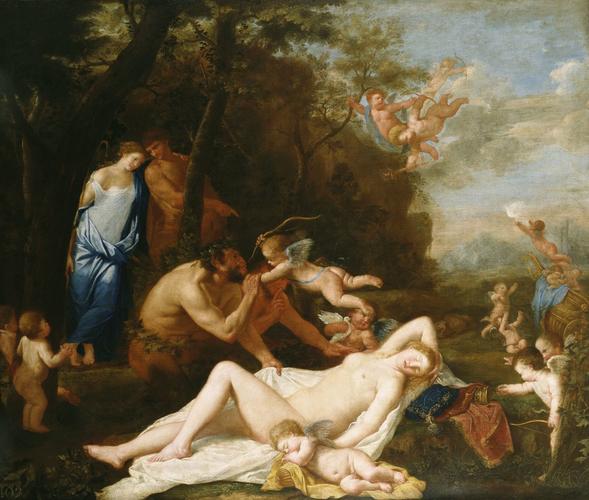Venus Sleeping, with Satyrs and Cupids c.1630-40
Oil on canvas | 146.1 x 170.2 cm (support, canvas/panel/stretcher external) | RCIN 405568
-
Spierincks was a pupil of Michel de Boerdous in Brussels and joined the guild there in 1622, but he was in Rome by 1624 and briefly a pupil of Paul Bril, before the latter’s death in 1626. By 1630 Spierincks is documented as sharing a house with the Flemish sculptor François Duquesnoy (1597-1643), who had also previously shared with the Frenchman Nicolas Poussin (1594-1660). More than any other factor it was the example of Poussin that formed Spierinck’s style.
During Poussin’s first decade in Rome (1624-34) he created a genre of mythological landscapes based upon Titian’s famous Bacchanales (one now in the National Gallery, London, and two in the Prado, Madrid) and on the pastoral love poetry of classical antiquity such as the Eclogues of Virgil. Some of these early Poussins, like Venus and Adonis (Kimbell Art Museum, Fort Worth, Texas), seem to be playful and erotic celebrations of the idyllic life of Arcadia, as well as having a serious undertone. Venus with Satyrs and Cupids is modelled on this lighter side of early Poussin, so closely that it was attributed to him within a few years of its arrival in England. However, in the original list of paintings bought by Charles II from William Frizell in 1660 it is described as by ‘Carlo Filippo’, the usual way in which Italians referred to Karel Philips Spierincks. The style of this painting is consistent with documentary references to Spierincks, and it has become an important work in reconstructing an oeuvre for this otherwise elusive artist.
On one level this painting illustrates the traditional contrast between sacred and profane love. The figure of Venus is erotically displayed in the careless abandon of sleep. Two satyrs - hideously red-blooded and bestial - spy upon her voyeuristically. One putto fights off a satyr by grabbing him by the beard, a classic image of the struggle between love and lust. Two putti descending, one with a torch (symbol of Hymen, god of marriage), seem to be coming to the aid of their companion. However, to the pure in heart Venus appears bright as well as alluring; with her drapery she makes a crescent of white like a new moon (that symbol of her spiritual opposite, the chaste Diana). A pair of rustic lovers contemplate her with reverence, as if she might bless their union, while they embrace each other with a spiritual tenderness.
On another level the painting reminds us that when Venus sleeps her infant attendants run amok, like naughty boys exploiting a lapse in supervision. One steals arrows, another releases Venus’s doves in order that his friends can use them for archery practice. In the top right corner a tiny putto is seen pursuing a fleeing dove with an arrow far into the distance. One putto, sheltering a dove and red-faced with indignation, tries to wake Venus to prevent the carnage.
Catalogue entry adapted from Bruegel to Rubens: Masters of Flemish Painting, London, 2007Provenance
Acquired by Charles II in 1660 for £60 from William Frizell at Breda (List II no 34) as Carlo Filippo; recorded in the 2nd Privy Lodging Room at Whitehall in 1666 (no 184) as Poussin
-
Creator(s)
Acquirer(s)
-
Medium and techniques
Oil on canvas
Measurements
146.1 x 170.2 cm (support, canvas/panel/stretcher external)
160.5 x 188.0 x 5.5 cm (frame, external)
Category
Object type(s)
Other number(s)
Alternative title(s)
A sleeping nymph with satyrs and cupids
A satyr and a sleeping nymph
A Venus with satyrs, cupids and landscape
Nymphs and satyrs








